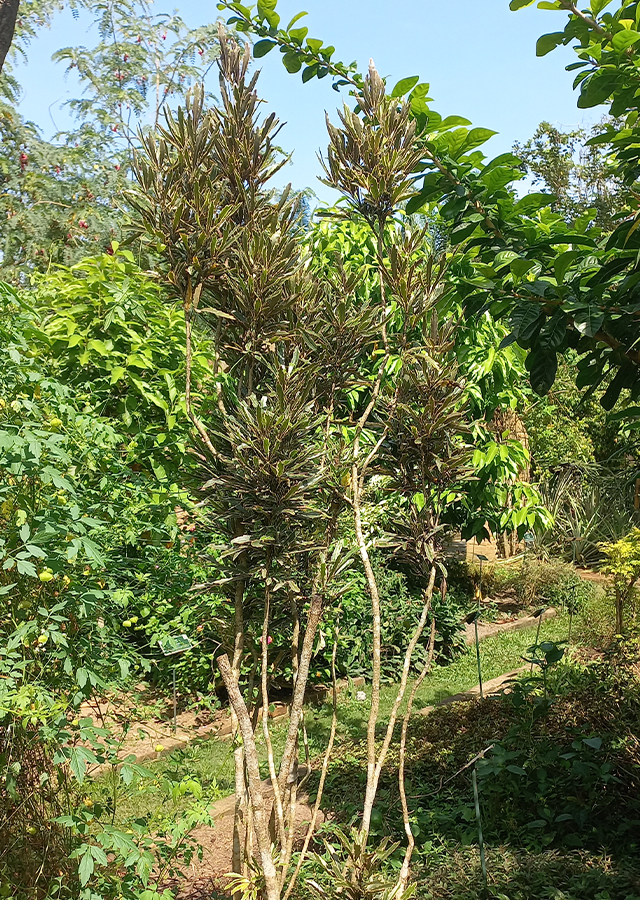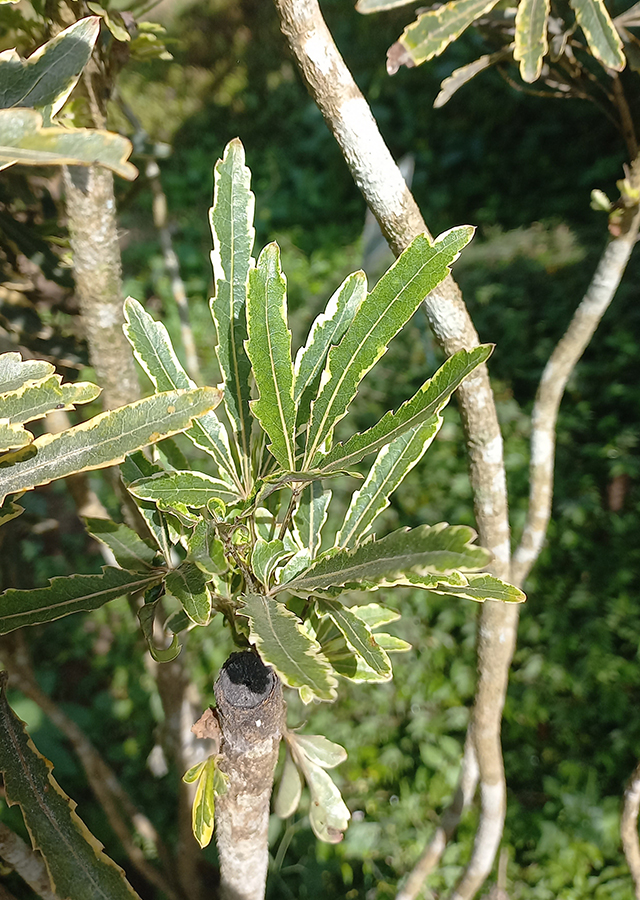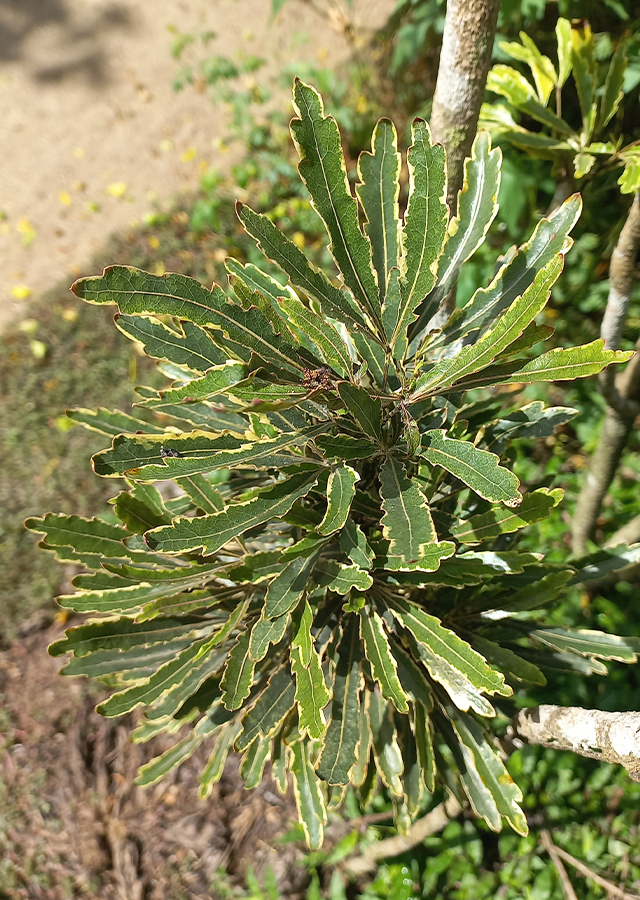False Aralia
Plerandra elegantissima (H.J.Veitch ex Mast.) Lowry, G.M.Plunkett & Frodin
Araliaceae
Location in our garden
Principal



Synonym
Aralia elegantissima H.J.Veitch ex Mast.
Schefflera elegantissima (H.J.Veitch ex Mast.) Lowry & Frodin
Schefflera faguetii Baill.
Habitus
Trees. An evergreen perennial, erect shrub or tree, growing 8-15 m tall.
Part Used
Leaves
The Whole Plant
Growing Requirements
Need Shade
Habitat
Forest
Shrublands
Overview
Plerandra elegantissima is native to south-east New Caledonia. It is has environmental uses for its ornamental leaves which offers feathery green leaves edged in gold. It is a good specimen plant in tubs for home and commercial office corners, atria, or as a specimen tree in larger interior landscape sites. It is a commonly cultivated outdoor tree in Hawaii, Florida & parts of California. Due to the reduction of the habitat caused by the excessive anthropization the species has been inserted into the the red list of the IUCN (International Union for Conservation of Nature) among the species at very high risk of extinction in the next future (“Endangered”).
Vernacular Names
Petit houx caledonien (French), Fingeraralie (German).
Agroecology
Often grown as a houseplant in temperate regions. It requires full sun or slight shade, averagely high temperatures and atmospheric humidity and draining soils, loose, rich of organic substance, slightly acidic to neutral, maintained almost constantly humid. Keeping the potting soil moist will benefit this plant. As plant in pot for the decoration in particularly luminous inner spaces, avoiding the direct sun, with temperatures preferably over the 16 °C and medium-high humidity.
Morphology
- Stem - dark green with white macules.
- Leaves - its leaflets are stalked, narrow, oblong, on a 10-14 cm long petiole in the young plants, 30-40 cm in the adult ones, are alternate, palmate-compound, formed by 7-12 leaflets almost linear with grossly and irregularly dentate margins, 13-25 cm long and 1-2 cm broad in the young plants or in the branches growing at the base of mature specimens, 20-30 cm long and 7-8 cm broad in the adult plants. The leaves are initially brown purple, then glossy dark green edged in gold, coriaceous, with prominent greenish white central vein.
- Flower - umbel compound terminal inflorescences with numerous small hermaphroditic pentamerous flowers of yellow-greenish colour.
- Fruit - sub-globose, of about 1 cm of diameter, of blackish colour containing usually 5-6 seeds.
- Seed - pale yellow seeds.
Cultivation
- Generatively propagated by seed, previously kept in water for 2 days, placed superficially in sandy organic loam maintained humid at the temperature of 24-26 °C, with germination times, if fresh, of 3-5 weeks.
- Vegetatively propagated by cutting and layering - even if with difficulty, by cutting in spring-summer and by air layering in spring.
Chemical Constituents
Sulfated oleanane-type triterpenoid, five known saponins of oleanane-type (echinocystic acid 3-O-β-D-glucopyranosyl-(1→3)-β-D-glucopyranosyl-(1→2)-α-L-arabino-pyranoside, 28-O-α-L-rhamnopyranosyl-(1→4)-β-D-glucopyran-osyl-(1→6)-β-D-glucopyranosyl ester, 3-O-β-D-glucopyranosyl-(1→2)-α-L-arabinopyranoside 28-O-α-L-rhamnopyranosyl-(1→4)-β-D-glucopyranosyl-(1→6)-β-D-glucopyranosyl ester, 3-O-α-L-arabinopyranoside, 28-O-α-L-rhamnopyranosyl-(1→4)-β-D-gluco-pyranosyl-(1→6)-β-D-glucopyranosyl ester, 3-O-α-L-arabinopyranoside, and oleanolic acid 3-O-sulfate.
Traditional Medicinal Uses
Study showed cytotoxicity, anti-Leishmania and anti-microbial activities. Further research is needed to confirm the traditional medicinal uses of this species.
Part Used
Reference Sources
- Kew Royal Botanic Gardens. (No date). Plants of the World Online: Plerandra elegantissima https://powo.science.kew.org/taxon/urn:lsid:ipni.org:names:77131172-1. 04-04-2022.
- Monaco Nature Encyclopedia. (No date). Plerandra elegantissima. https://www.monaconatureencyclopedia.com/plerandra-elegantissima-2/?lang=en. 04-04-2022.
- National Park of singapore. (2021). Flora & Fauna Web: Plerandra elegantissima (H.J.Veitch ex Mast.) Lowry et al. https://www.nparks.gov.sg/florafaunaweb/flora/2/4/2440. 04-04-2022.
- North Carolina Cooperative Extension. (No date). North Carolina Extension Gardener Plant Toolbox: Plerandra elegantissima. https://plants.ces.ncsu.edu/plants/plerandra-elegantissima/. 04-04-2022.
- Wanas, A.S., et al. (2013). Bioactive Triterpene Saponins from the Leaves of Schefflera elegantissima. Natural Product Communications, 8(6):767-76. DOI: 10.1177/1934578X1300800621.
